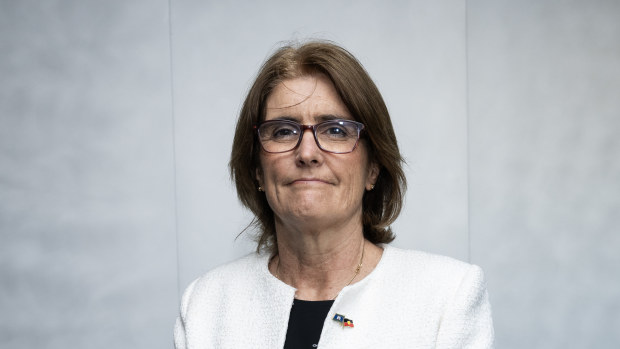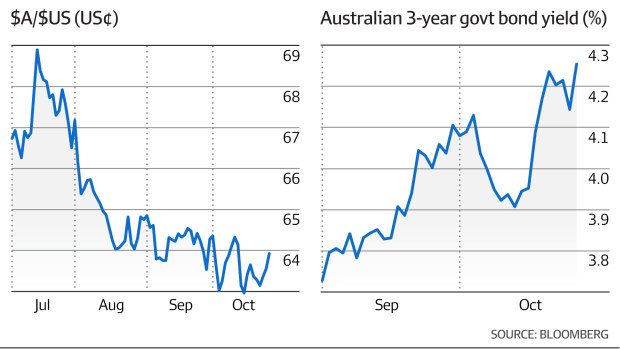Markets lock in pre-Christmas rate rise

Financial markets locked in a Reserve Bank cash rate increase by Christmas, tipping the sharemarket to the cusp of a correction, as the ramifications of the RBA’s tightening bias under new governor Michele Bullock sunk in.
Stronger than expected inflation in the September quarter heaped pressure on the RBA to break its monetary pause and raise the cash rate on Melbourne Cup Day to 4.35 per cent from 4.1 per cent.

RBA governor Michele Bullock on Tuesday night. Louie Douvis
The S&P/ASX 200 Index is within a percentage point of a correction from its February 6 high of 7567.70, meaning a 10 per cent decline from its cyclical peak. It closed at 6854.3 on Wednesday, down 2.6 points and 9.4 per cent off its 2023 high.
The Australian dollar rallied 0.5 per cent to US63.87¢, drifting from a low of US62.83¢ touched early this month. The local dollar has shaved off more than US4¢ this year, largely because of interest rate differentials between the US and Australia.

Government bond yields jumped. The three-year rate was up seven basis points to a three-month high of 4.28 per cent. The 10-year yield added three basis points to hit 4.73 per cent. Global bond yields have been on a tear since May on expectations interest rates will stay higher for longer than previously thought.
Bond traders ramped up their bets of a rate increase next Tuesday to 65 per cent, from a one-in-three chance before the CPI result. They are fully priced for an increase by year’s end and ascribe a 50 per cent chance of a follow-up move to 4.6 per cent in 2024.
All key inflation components beat economists’ forecasts as petrol prices and rents soared. Headline CPI accelerated 1.2 per cent in the quarter, topping forecasts of 1.1 per cent. Annually, the pace of inflation slowed to 5.4 per cent, from 6 per cent, but came in above expectations of 5.3 per cent.
“It was certainly hot numbers all around and the RBA has little room to move in the inflation fight,” said Matt Wacher, chief investment officer at Morningstar for the Asia Pacific region.
Painful result
Core inflation, the RBA’s preferred measure because it strips out volatile price movements, quickened to 1.2 per cent, above forecasts of 1.1 per cent.
More importantly, it came in far above the RBA’s own projection of 0.9 per cent published in the August economic update. The annual core inflation rate cooled to 5.2 per cent, but topped expectations of 5 per cent. It’s well outside the central bank’s target range of 2 per cent to 3 per cent.
Indeed, the result will not please Ms Bullock, who on Tuesday said she would not hesitate to raise rates if there was a material revision to the outlook for inflation.
Ophir Asset Management head of research Luke McMillan said: “I think this will be enough to push them over the edge to hike to 4.35 per cent next month.”
The strong data prompted economists to abandon their predictions of the RBA extending its rate pause. ANZ and Commonwealth Bank now forecast an increase in November.
“There is a risk it could tighten beyond that. Any easing remains a very long way off,” said ANZ head of Australian economics Adam Boyton.
A few days ago, bond traders had ascribed a one-in-three chance to the prospect of a rate cut by late next year.
Global outlier
Fortlake Asset Management co-founder Christian Baylis said the RBA’s focus should be firmly set on returning inflation to its target by late 2025, noting that the timeline was originally mid-2025, before the central bank pushed it out further.
“If they were to sneak out the timing into 2026, that is a quasi-easing of policy, not a tightening,” he said. He is calling for an increase next month, stressing that Australia is one of the few major economies to still have a real negative interest rate. “[The RBA] are a global outlier.”
Australia’s policy rate remains well below its peers. The US benchmark sits at a mid-point of 5.37 per cent, the New Zealand policy rate is 5.5 per cent, and Britain’s is 5.25 per cent.
The RBA has kept the cash rate on hold at 4.1 per cent since July, waiting for the past 12 increases to take full effect, while safeguarding gains it has made in employment.
“They want to have their cake and eat it too,” Mr Baylis said. “If you want to preserve those benefits, you have to pay a price and the price is ultimately stickier inflation if you don’t front-end load policy.”
However, Jamieson Coote Bonds said raising rates would not make a big difference in lowering the prices that drove inflation higher this quarter, citing global oil price benchmarks and the cost of insurance bills due to climate change.
“The lag effects of the past rate rises are only starting to come through now, so if you’re doing a rate hike in November, it’s probably not going to show up until this time next year,” said Angus Coote, co-founder of Jamieson Coote Bonds.
He anticipates the RBA will lift rates next month for the last time this cycle. “But they might look back in six months’ time and go, ‘that was a mistake’, because the economy might roll quickly,” he said.
Introducing your Newsfeed
Follow the topics, people and companies that matter to you.
Find out moreRead More
Latest In Debt markets
Fetching latest articles